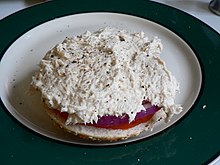
Mayonnaise, colloquially referred to as "mayo", is a thick, cold, and creamy sauce commonly used on sandwiches, hamburgers, composed salads, and French fries. It also forms the base for various other sauces, such as tartar sauce, fry sauce, remoulade, salsa golf, ranch dressing, and rouille.

Potato salad is a salad dish made from boiled potatoes, usually containing a dressing and a variety of other ingredients such as boiled eggs and raw vegetables. It is usually served as a side.
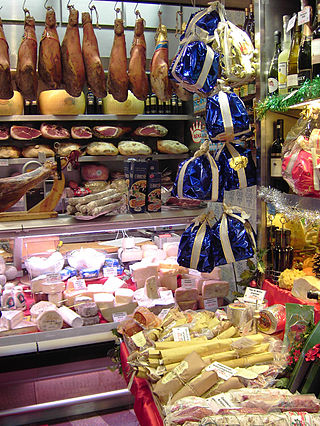
Traditionally, a delicatessen or deli is a grocery that sells a selection of fine, exotic, or foreign prepared foods. Delicatessens originated in Germany during the 18th century and spread to the United States in the mid-19th century. European immigrants to the United States, especially Ashkenazi Jews, popularized the delicatessen in U.S. culture beginning in the late 19th century. Today, many large retail stores like supermarkets have deli sections.
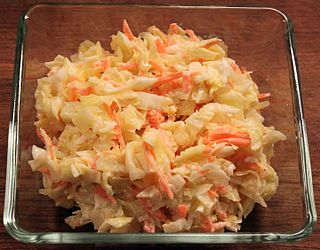
Coleslaw or cole slaw, also known simply as slaw, is a side dish consisting primarily of finely shredded raw cabbage with a salad dressing or condiment, commonly either vinaigrette or mayonnaise. This dish originated in the Netherlands in the 18th century. Coleslaw prepared with vinaigrette may benefit from the long lifespan granted by pickling.

Bialy, originally from the city of Białystok in Poland, is a traditional bread roll in Polish Ashkenazi Jewish cuisine.

Jewish cuisine refers to the worldwide cooking traditions of the Jewish people. During its evolution over the course of many centuries, it has been shaped by Jewish dietary laws (kashrut), Jewish festivals and holidays, and traditions centred around Shabbat. Jewish cuisine is influenced by the economics, agriculture, and culinary traditions of the many countries where Jewish communities have settled and varies widely throughout the entire world.

An appetizing store, typically in reference to Jewish cuisine in New York City, particularly Ashkenazi Jewish cuisine, is a store that sells "food that generally goes with bagels", although appetizings can also be served with a variety of breads. Appetizings include smoked and pickled fish and fish spreads, pickled vegetables, cream cheese spreads and other cheeses.

Kosher style refers to Jewish cuisine—most often that of Ashkenazi Jews—which may or may not actually be kosher. It is a stylistic designation rather than one based on the laws of kashrut. In some U.S. states, the use of this term in advertising is illegal as a misleading term under consumer protection laws.
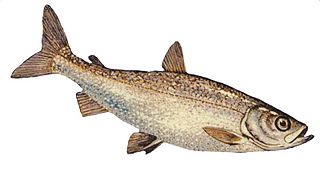
The freshwater whitefish are fishes of the subfamily Coregoninae, which contains whitefishes and ciscoes, and is one of three subfamilies in the salmon family Salmonidae. Apart from the subfamily Coregoninae, the family Salmonidae includes the salmon, trout, and char species of the subfamily Salmoninae, and grayling species of the subfamily Thymallinae. Freshwater whitefish are distributed mainly in relatively cool waters throughout the northern parts of the Northern Hemisphere.

Israeli cuisine primarily comprises dishes brought from the Jewish diaspora, and has more recently been defined by the development of a notable fusion cuisine characterized by the mixing of Jewish cuisine and Arab cuisine. It also blends together the culinary traditions of the various diaspora groups, namely those of Middle Eastern Jews with roots in Southwest Asia and North Africa, Sephardi Jews from Iberia, and Ashkenazi Jews from Central and Eastern Europe.
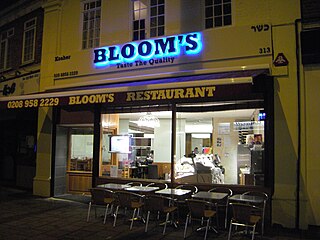
A kosher restaurant or kosher deli is an establishment that serves food that complies with Jewish dietary laws (kashrut). These businesses, which also include diners, cafés, pizzerias, fast food, and cafeterias, and are frequently in listings together with kosher bakeries, butchers, caterers, and other similar places, differ from kosher-style businesses in that they operate under rabbinical supervision, which requires the observance of the laws of kashrut, as well as certain other Jewish laws, including the separation of meat and dairy.

Olivier salad is a traditional salad dish of Russian cuisine. Its creation is generally attributed to Lucien Olivier.

A bagel and cream cheese is a food pairing that consists, in its basic form, of a sliced bagel spread with cream cheese. Bagels with cream cheese are traditionally and most commonly served sliced horizontally and spread with cream cheese and other toppings.

American Jewish cuisine comprises the food, cooking, and dining customs associated with American Jews. It was heavily influenced by the cuisine of Jewish immigrants who came to the United States from Eastern Europe around the turn of the 20th century. It was further developed in unique ways by the immigrants and their descendants, especially in New York City and other large metropolitan areas of the northeastern U.S.

Texas smoked brisket or barbecue brisket, is an American dish made with brisket that is popular in Texas.

Ashkenazi Jewish cuisine is an assortment of cooking traditions that was developed by the Ashkenazi Jews of Central, Eastern, Northwestern and Northern Europe, and their descendants, particularly in the United States and other Western countries.

A Jewish deli, also known as a Jewish delicatessen, is a store that serves various traditional dishes of Jewish cuisine, mostly Ashkenazi Jewish cuisine. Known for their robust sandwiches, such as pastrami on rye, they also specialize in traditional Jewish diaspora soups and other ethnically rooted dishes. As retail delicatessens, most also sell a selection of their products such as sliced meats by the pound, prepared salads, pickles, and offer dine-in or take-out.
Smoked sable, is sablefish that has been smoked. Smoked sable is often prepared with paprika.
